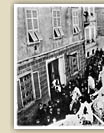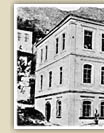|
|
 |
 |
 |
 |
 |
 |
 |
 |
 |
 |
|
Macedonia formed part of the Ottoman Empire and was divided
into three vilayets (provinces): Thessaloniki, Monastir and Skopje.
|

These areas were inhabited by Greek-, Slav-, Vlach- and Albanian-speaking Christian populations,
as well as Turkish- and Albanian-speaking Muslims. The Greek-speaking populations constituted the majority, mostly
in the south, while the Slav-speakers were densely concentrated in the north.
From the 1860s an ecclesiastical issue had arisen (practically a schism) between the Ecumenical
Patriarchate and the Bulgarian Exarchate. Up to the beginning of the twentieth century
great pressure was exerted on native Macedonians, especially Slav-speakers,
to recognize the Exarchate as their eccclesiastical authority, and, accordingly, to secede from the Patriarchate. However,
in many cases they did not wish to integrate with the Exarchate with which
they shared the same language, opting instead to continue being under the influence of the Patriarchate. But these groups, and the
Greek-speaking populations who were Greek-educated and belonged to the Church of Constantinople,
became the target of intense and violent pressure on account of their religious views on
the part of the Exarchate.
In the late nineteenth century this ecclesiastical issue became the focus of conflict concerning the national
claims of Greece and Bulgaria. The Macedonian Question formed part of the Eastern Question, that is the
management of the crumbling Ottoman Empire and especially the partitioning of its European territories among
the new national states of the Balkans. At the same time, the influence of the Great Powers (who were reinforcing competition and clashes) was under discussion. The Bulgarian Principality
was trying to expand its influence over and annex the territories created by the Treaty of San Stephano (1878), that is, approximately the whole of Macedonia, claiming as its supporters the
Exarchist populations. At the same time, the Internal Macedonian Revolutionary Organization (IMRO) was
established with the aim of creating an autonomous Macedonia. It is not clear whether this aspiration was genuine.
|
 |

It is likely that autonomy would be a first step towards the annexation of Macedonia to Bulgaria,
as had happened with Eastern Rumelia in 1885. What is certain is that there was dissension
between IMRO and the Supreme Macedonian Committee of Sofia (the Vrchovists).
In the period after 1897, Bulgarian propaganda intensified. In October 1902 the first Sofia-inspired
uprising broke out. Despite its failure, a second uprising was organized in July 1903 by
IMRO; it was known as the Ilinden uprising. It, too, was suppressed, but
the overall mobility of the Bulgarians projected the Macedonian Question onto a European
plane as a primarily Bulgarian issue, who would be favoured by possible
future regulations.
The Greek Patriarchists reacted by intensifying their efforts in matters of education and the establishment of
Greek schools. Generally speaking, the Greek state was too aware of its 1897 defeat and the needs of internal reconstruction to take any particular interest in
the events taking place in Macedonia. But individuals were enlisted to
organize Greek guerilla bands that would counter-balance the activity of the armed Exarchists, the
komitadjis (from the word committee), a Bulgarian organization to control operations in Macedonia).
Germanos Karavangelis, Metropolitan of Kastoria, organized the first armed bands of the Patriarchists,
recruiting various Slav-speaking leaders, such as Kotas and Gueleff, who had
collaborated with the IMRO. At the same time, the appointment of competent diplomats in the
consulates of Macedonia, such as Ion Dragoumis and Lambros Koromilas, upgraded Greek reaction.
In 1903 a Macedonian Committee was established in Athens by the publisher Dimitris Kalopothakis, who
undertook the coordination of the activity of the Greeks in Macedonia and their material and military
aid.
|
 |
 |
|
